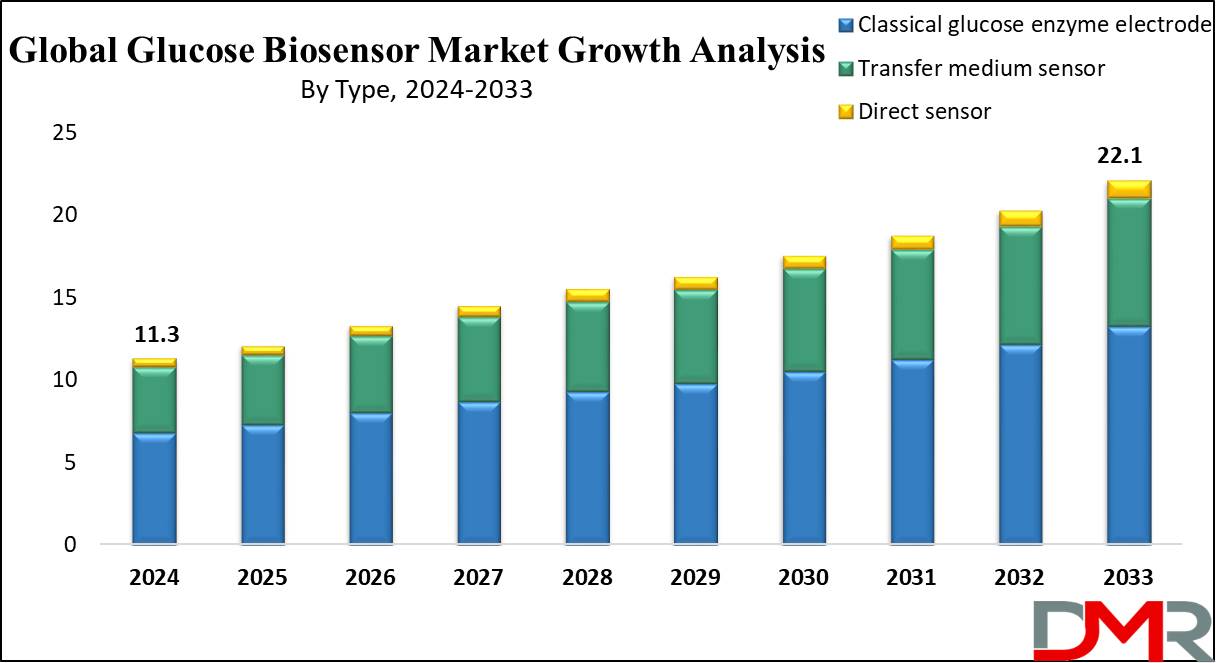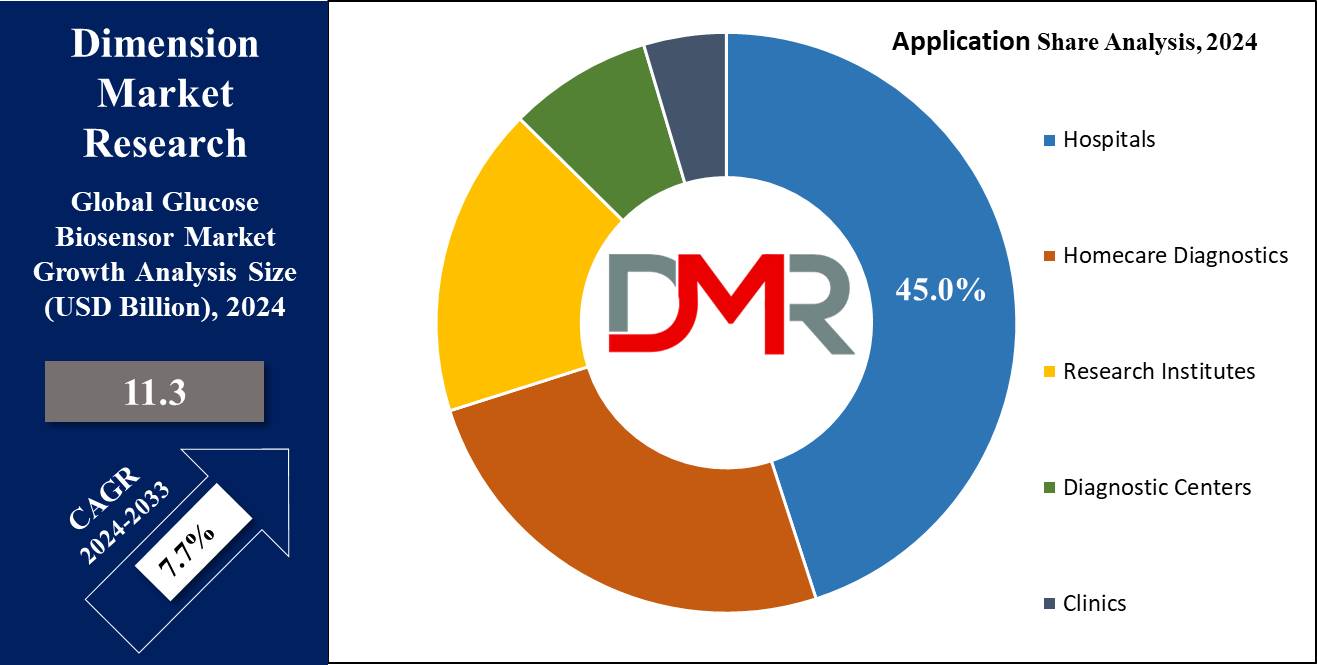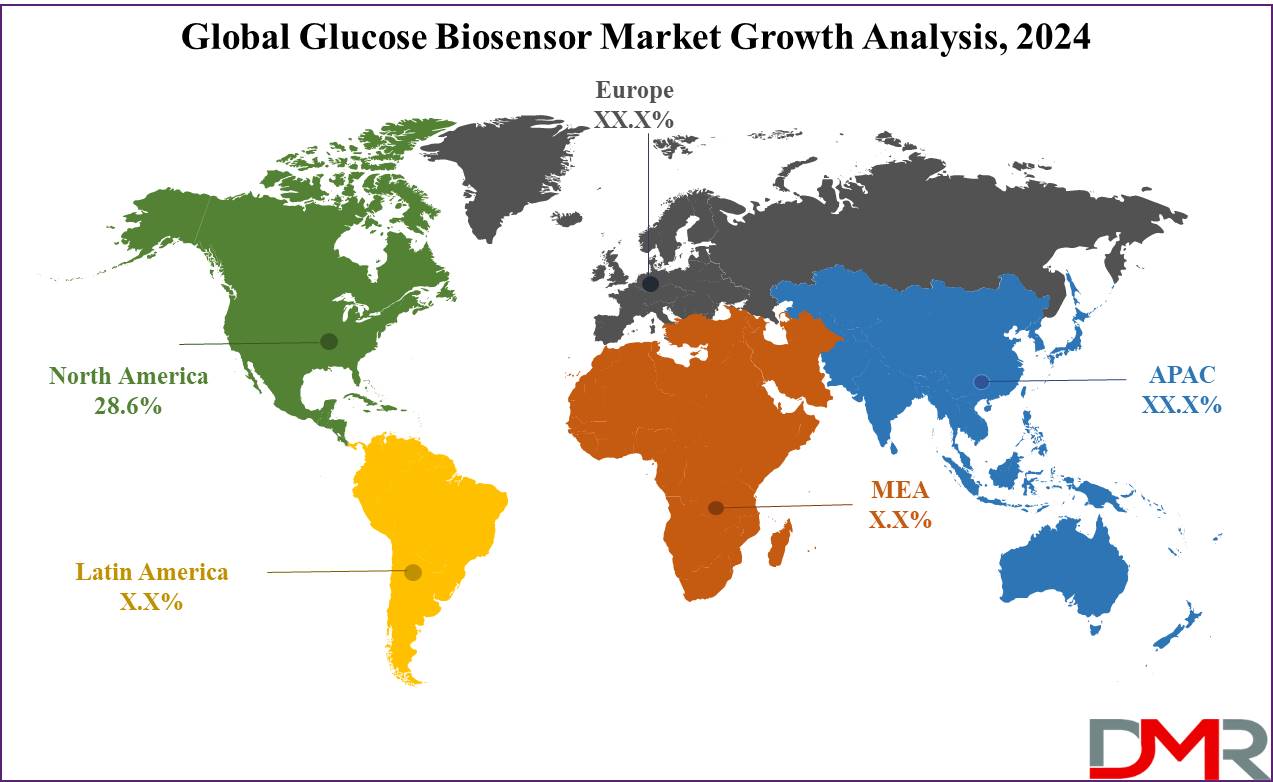Overview
Global Glucose Biosensor Market size was valued at USD 11.3 Bn in 2024 and it is further anticipated to reach a market value of USD 22.1 Bn in 2033 at a CAGR of 7.7%.

Globally, diabetes prevalence is on the rise due to factors like sedentary lifestyles, obesity and an aging population thus necessitating effective glucose monitoring solutions as more people fall ill with it. Glucose biosensors play an integral part in managing diabetes by offering accurate blood sugar level measurements. With ever-evolving sensor technologies, their functionality and user friendliness continue to advance.
CGM systems and miniaturized sensors are revolutionizing glucose monitoring, offering greater convenience and precision than ever before. Their advancement has greatly increased demand for glucose biosensors as they offer more reliable solutions for managing diabetes.
Global Glucose Biosensor Market report offers an in-depth analysis of the target market, encompassing factual data like market size and shares at both regional and country levels, with CAGR and year-on-year growth rates. The report gives crystal view on market trends, opportunities, restrains and challenges along with competitive landscape analysis. Porters Five Forces, PESTLE, supply-chain analysis, Ecosystem analysis and Macro economic factors are included to cover all the target market aspects.
The research report on the global glucose biosensor market includes both qualitative as well as quantitative analysis of the market, company profiles of major market players along with complete product details and their competitive scenario. The report highly exhibits on the current and upcoming market trends and provides comprehensive analysis of all the factors that impact the global glucose biosensor market growth and size. The report will help companies to make better strategical business decisions.
Key Takeaways
- Market Size & Share: Glucose Biosensor Market size was valued at USD 11.3 Bn in 2024 and it is further anticipated to reach a market value of USD 22.1 Bn in 2033 at a CAGR of 7.4%.
- Type Analysis: Classical glucose enzyme electrode devices dominated with over 60% market share.
- Application Analysis: Homecare Diagnostics held approximately 45% market share.
- Regional Analysis: North America led the global glucose biosensors market in 2024 with 28.6% revenue share.
- Technological Innovations: Continuous advancements in CGM systems and the development of non-invasive glucose monitoring technologies are significantly enhancing patient convenience and monitoring accuracy.
- Wearable Integration: The integration of glucose biosensors with wearable devices, such as smartwatches, is becoming more prevalent, providing seamless and continuous health monitoring capabilities.
- AI and Data Analytics: The incorporation of AI and advanced data analytics in glucose biosensors is improving predictive capabilities and offering personalized insights for better diabetes management.
Use Cases
- Diabetes Management: Diabetics often use glucose biosensors to track their blood sugar levels regularly and adjust diet or medication as necessary. Regular monitoring makes for effective management and adjustment.
- Continuous Glucose Monitoring (CGM): Continuous Glucose Monitoring (CGM), which acts like a biosensor for glucose, allows real-time tracking of blood sugar levels all day and night for improved glycemic control and early identification of any blood sugar fluctuations.
- Pre-Diabetes and Risk Evaluation: Biosensors can also be used for monitoring glucose levels among those at high risk for developing diabetes, providing early intervention as well as lifestyle modifications that could prevent its occurrence altogether.
- Clinical Studies: Glucose biosensors can be utilized as part of clinical research studies to examine the impact of new diabetes treatments or interventions, providing precise data regarding glucose regulation and treatment efficacy.
- Athletic Performance: Athletes and fitness enthusiasts use glucose biosensors during exercise to monitor their glucose levels to optimize performance and recovery while maintaining an optimum energy source.
Market Dynamics
Driving Factors
Diabetes is the primary force driving glucose biosensor sales worldwide. Fueled by factors like lifestyles such as sitting for too long, poor dietary choices and an aging population, diabetes necessitates effective monitoring and management solutions such as glucose biosensors to keep control of blood sugar levels and prevent complications from developing. Rising prevalence has raised awareness of regular glucose monitoring; driving up demand even further as personalized healthcare increases demand.
Trending Factors
A key trend in the glucose biosensor market is the growing adoption and development of continuous glucose monitoring (CGM) systems, unlike traditional blood glucose meters which provide real-time data on a patient's blood glucose levels only during certain hours of the day and night. CGM systems allow patients to gain more complete and timely understanding of their own glycemic trends with this technology, leading to timely interventions and better glycemic control while increasing quality of life for individuals living with diabetes. Furthermore, developments in sensor technology such as miniaturized devices integrated with smartphone apps make glucose monitoring more accessible, thus encouraging widespread adoption by patients.
Restraining Factors
One of the primary barriers to market growth for glucose biosensors is their high cost. While advanced monitoring systems offer many benefits, their expense may be prohibitive for many low- and middle-income regions - restricting access and adoption rates of these biosensors. In addition, some advanced devices require patients possess a certain level of technical proficiency which could prove challenging for elderly or less familiar users as well as regulatory challenges or the requirement for constant innovation limiting market expansion.
Opportunity
The glucose biosensor market offers substantial opportunities, particularly with an increasing emphasis on preventive healthcare and early diagnosis. Governments and healthcare organizations are placing greater emphasis on regular health screenings and proactive management of chronic conditions, creating an ideal setting for glucose biosensor adoption. Emerging markets such as Asia-Pacific and Latin America hold great promise due to improving healthcare infrastructure and increasing awareness. Furthermore, non-invasive glucose monitoring technologies combined with telemedicine services represent tremendous growth potential, as they enhance patient convenience while expanding reach of glucose monitoring solutions.
The COVID-19 Pandemic & Recession: Impact on the Global Glucose Biosensor Market:
Dimension Market Research has closely monitored the impact of COVID-19 and the recession on specific business segments, along with its short and long-term implications at both the global and regional levels. The initial outbreak of the COVID-19 pandemic caused unprecedented economic damage across numerous regions. The COVID-19 pandemic severely disrupted production, sales, and supply chain activities in developed as well as developing economies. Our report comprehensively covers the pre and post-COVID-19 impacts, along with an analysis of the recession's effects on the global glucose biosensor market.
Research Scope and Analysis
Type Analysis
In the Glucose Biosensor Market, various sensors are utilized for monitoring blood glucose levels. As of 2023, Classical glucose enzyme electrode devices dominated with over 60% market share. Biosensors that utilize glucose oxidase or dehydrogenase enzymes to detect glucose levels have become widely popular due to their accuracy, reliability, and relatively lower cost compared to other options. Transfer medium sensor products make up approximately 25% of this market segment. These sensors utilize a transfer medium for detection purposes, providing reliable performance at a higher price point.
Direct sensors account for about 15% of the market and use advanced technologies to directly measure glucose levels, providing potential advantages in terms of non-invasiveness and continuous monitoring; however, higher costs and technical complexities limit widespread adoption. Classic enzyme electrodes remain more popular due to their proven efficacy, ease of use, and cost effectiveness in managing diabetes.
Application Analysis
In the Glucose Biosensor Market, various application segments utilize these devices to monitor and control blood glucose levels. By 2023, Homecare Diagnostics held approximately 45% market share. Homecare diagnostics' dominance can be explained by both diabetes' increasing prevalence and patient trends towards self-monitoring for better disease management. Homecare diagnostics allow them to regularly check glucose levels from within their own homes without incurring additional fees for services. Hospitals command approximately 25% of the market, using glucose biosensors for both inpatient and outpatient care.

Clinics and Diagnostic Centers each hold around 15%, providing essential diagnostic services and ongoing patient monitoring services. Research Institutes comprise approximately five percent of the market and use glucose biosensors in clinical studies and the development of new treatments. Homecare diagnostics have become more popular as home monitoring provides continuous monitoring, patient empowerment, and ease of managing diabetes outside traditional healthcare settings.
Market Analysis and Research Scope:
We provide Comprehensive insights about the glucose biosensor market along with crucial Key factors such as market size, market CAGR, market potential, recent developments, trends, opportunities, new technologies and innovations, recent product launches, restraints and market regulations. This report will help our clients immensely in getting an inside out view of the glucose biosensor market by providing them with the complete information about the glucose biosensor market and its prominent players with their competitive analysis and strategies.
The global glucose biosensor market research report provides accurate estimations for the forecast period 2024 to 2033 based on in-depth research and analysis through rigorous compilation of exhaustive primary and secondary research data. The final data will be carried out after verifying the in-house research analysis by the key opinion leaders of the global glucose biosensor market. Our triangulate research method minimizes error margin and gives holistic view on the report.
The Global Glucose Biosensor Market Report is segmented on the basis of the following:
Type
- Classical glucose enzyme electrode
- Transfer medium sensor
- Direct sensor
Application
- Hospitals
- Homecare Diagnostics
- Research Institutes
- Diagnostic Centers
- Clinics
Geographical Segmentation of the Global Glucose Biosensor Market:
North America led the global glucose biosensors market in 2023 with 28.6% revenue share. Diabetes prevalence drove demand for accurate and efficient glucose monitoring devices such as continuous glucose monitors (CGMs) and point-of-care testing devices these advanced solutions provide real-time monitoring while offering convenient testing options to patients - essential tools in effective diabetes management! These devices provided reliable yet easily accessible glucose monitoring solutions.

Region and Countries
North America
Europe
- Germany
- The U.K.
- France
- Italy
- Russia
- Spain
- Nordic
- Benelux
- Rest of Europe
Asia-Pacific
- China
- Japan
- South Korea
- India
- ANZ
- ASEAN
- Rest of Asia-Pacific
Latin America
- Brazil
- Mexico
- Argentina
- Colombia
- Rest of Latin America
Middle East & Africa
- Saudi Arabia
- UAE
- Israel
- South Africa
- Egypt
- Rest of MEA
The global glucose biosensor market research report provides competitive examination analysis of the leading players including company description, SWOT analysis, and financial information, exhaustive product portfolio with specifications, key business areas, market share analysis, acquisitions and mergers, and key developments, etc.
Competitive Landscape:
The global glucose biosensor market is highly fragmented due to the presence of several leading players. Prominent market players of the glucose biosensor market are exhibiting a keen interest towards the emerging economies such as China, India, etc. to enhance their revenue generating opportunities. The major market players are continuously focusing on their product branding, marketing and expansion of R&D, to increase their customer base. Exhaustive key vendor analysis has been done to meet the ever-changing needs of our clients and provide them with a complete overview on the competitiveness of the global glucose biosensor market.
Global Glucose Biosensor Market Key Players:
Recent Developments
- CGM Advancements in 2023: Multiple companies debuted next-generation CGM systems with improved accuracy and extended sensor wear times in 2023, offering real-time glucose readings as well as integration with digital health platforms to increase patient convenience and compliance.
- Non-Invasive Glucose Monitoring: Advancements have been made in non-invasive glucose monitoring technologies. Some companies introduced prototypes and early stage products that measure glucose levels using skin patches or optical sensors - without needing finger pricks!
- Integration With Wearable Technology: Recently, glucose biosensors have become an increasingly popular trend for integration with wearable technology such as smartwatches and fitness trackers to enable continuous health monitoring and seamless data sharing with healthcare providers.
- Artificial Intelligence and Data Analytics: Recent advances have seen glucose biosensors equipped with artificial intelligence (AI) and advanced data analytics capabilities, helping predict glucose trends as well as providing personalized insights and recommendations for improved diabetes management.
Report Details
| Report Characteristics |
| Market Size (2024) |
USD 11.3 Billion |
| Forecast Value (2033) |
USD 22.1 Billion |
| CAGR (2024-2033) |
7.7% |
| Historical Data |
2018 – 2023 |
| Forecast Data |
2024 – 2033 |
| Base Year |
2023 |
| Estimate Year |
2024 |
| Report Coverage |
Market Revenue Estimation, Market Dynamics, Competitive Landscape, Growth Factors and etc. |
| Segments Covered |
By type(Impulse Sealing, Ultrasonic Sealing, Hot Bar Sealing), By end-use industry(Chemicals, Food Processing, Building Material/Aggregates, Agriculture, Pharmaceutical) |
| Regional Coverage |
North America – The US and Canada; Europe – Germany, The UK, France, Russia, Spain, Italy, Benelux, Nordic, & Rest of Europe; Asia- Pacific– China, Japan, South Korea, India, ANZ, ASEAN, Rest of APAC; Latin America – Brazil, Mexico, Argentina, Colombia, Rest of Latin America; Middle East & Africa – Saudi Arabia, UAE, South Africa, Turkey, Egypt, Israel, & Rest of MEA
|
| Prominent Players |
Bosch Packaging Technology,Audion Elektro,Newlong Machine Works,Pack Rite,Star Universal,Hualian,Plexpack,Hamer-Fischbein,APM,Zhejiang Dongfeng,Xingye Machine,Raylee,HACONA Packaging Machines,Hulme Martin,Dingye |
| Purchase Options |
We have three licenses to opt for: Single User License (Limited to 1 user), Multi-User License (Up to 5 Users), and Corporate Use License (Unlimited User) along with free report customization equivalent to 0 analyst working days, 3 analysts working days and 5 analysts working days respectively. |